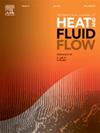To what extent does local oscillation influence the thermal performance of finned PCM-based energy storage systems: A numerical study
IF 2.6
3区 工程技术
Q2 ENGINEERING, MECHANICAL
International Journal of Heat and Fluid Flow
Pub Date : 2025-03-13
DOI:10.1016/j.ijheatfluidflow.2025.109798
引用次数: 0
Abstract
Enhancing the thermal performance of phase change materials (PCMs) is vital for improving the efficiency of energy storage systems. While fins are widely used to expedite the melting process by boosting thermal conductivity, their effectiveness diminishes as melting progresses and natural convection becomes dominant. Meanwhile, local mechanical oscillation has emerged as a promising technique to further accelerate melting, though its isolated use has been the primary focus of prior studies. The combined effect of fins and local oscillation, particularly their interaction in influencing the heat transfer dynamics of PCM, remains unexplored. Thus, this study develops a numerical model to investigate the interaction between various fin configurations (namely, sinusoidal, and positive/negative straight fins) and local oscillation within a finned rectangular enclosure. Moreover, the local oscillator’s placement on the hot wall, as well as its proximity to the fins, are among key factors analyzed. The results demonstrate that negative rectangular fins consistently deliver superior thermal performance, while the effectiveness of local oscillation diminishes when placed between fins, particularly as the melting front progresses. The optimal configuration is a vertical oscillator positioned at the base of the hot wall near a negative fin, which achieves a 64.3 % reduction in melting time. Notably, as the lower fin is installed closer the bottom wall of the enclosure, two distinct mechanisms arising from extension of the heating area and local flow stimulation by the oscillator plate, though differing fundamentally, result in similar effects during the later stages of the melting process, thereby diminishing the overall influence of localized oscillation on the melting process.
求助全文
约1分钟内获得全文
求助全文
来源期刊

International Journal of Heat and Fluid Flow
工程技术-工程:机械
CiteScore
5.00
自引率
7.70%
发文量
131
审稿时长
33 days
期刊介绍:
The International Journal of Heat and Fluid Flow welcomes high-quality original contributions on experimental, computational, and physical aspects of convective heat transfer and fluid dynamics relevant to engineering or the environment, including multiphase and microscale flows.
Papers reporting the application of these disciplines to design and development, with emphasis on new technological fields, are also welcomed. Some of these new fields include microscale electronic and mechanical systems; medical and biological systems; and thermal and flow control in both the internal and external environment.
 求助内容:
求助内容: 应助结果提醒方式:
应助结果提醒方式:


